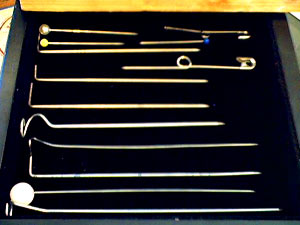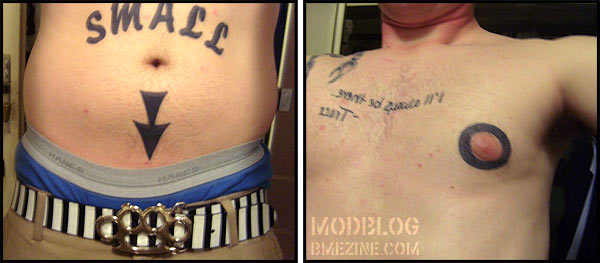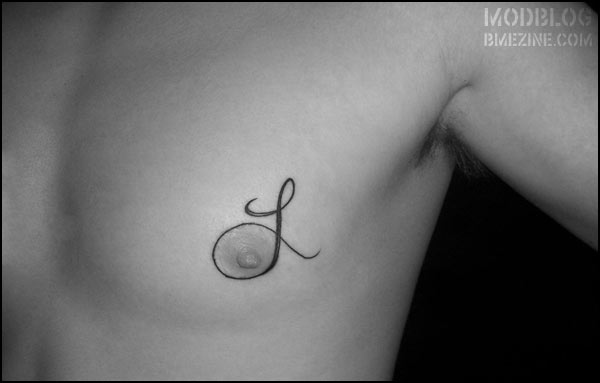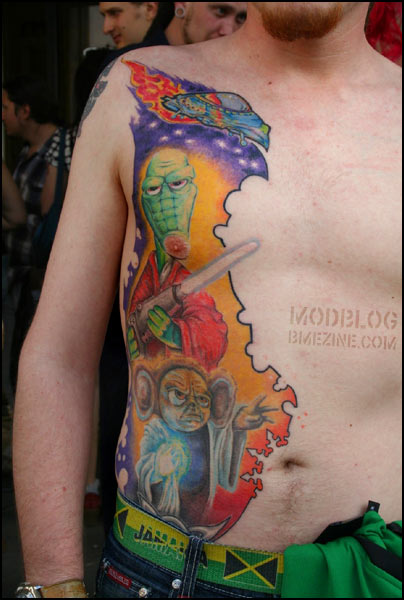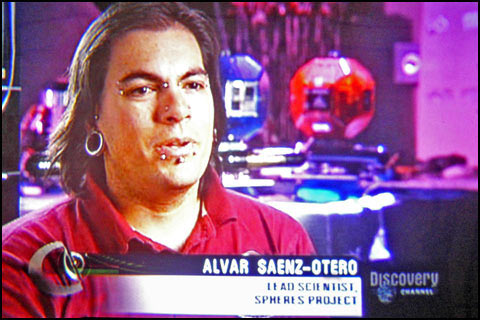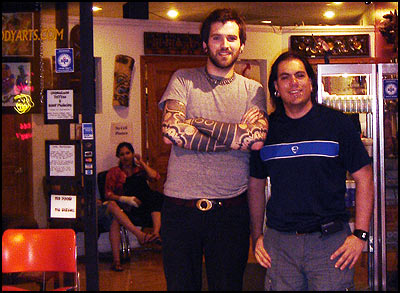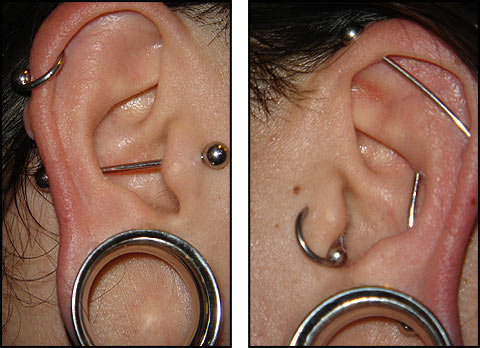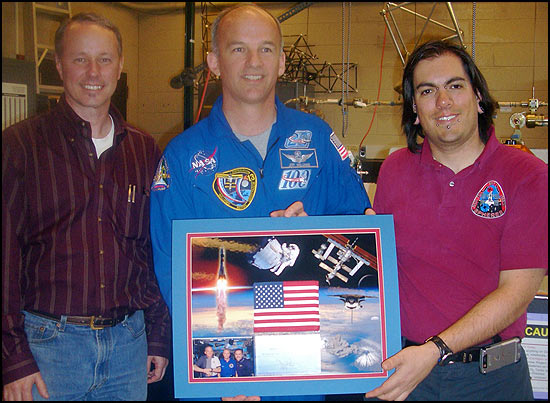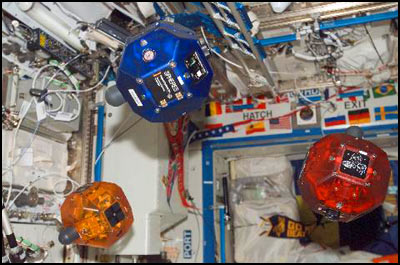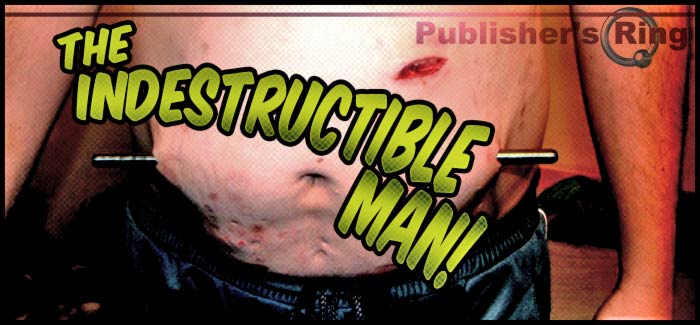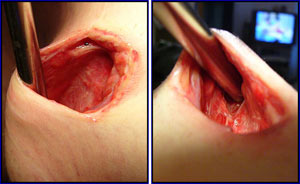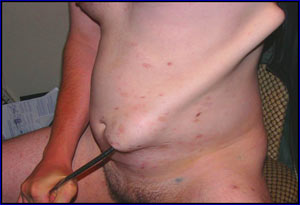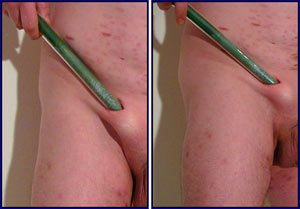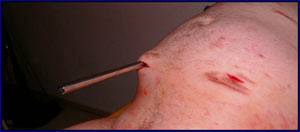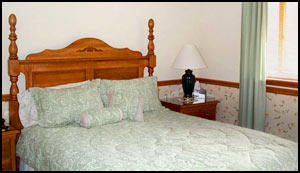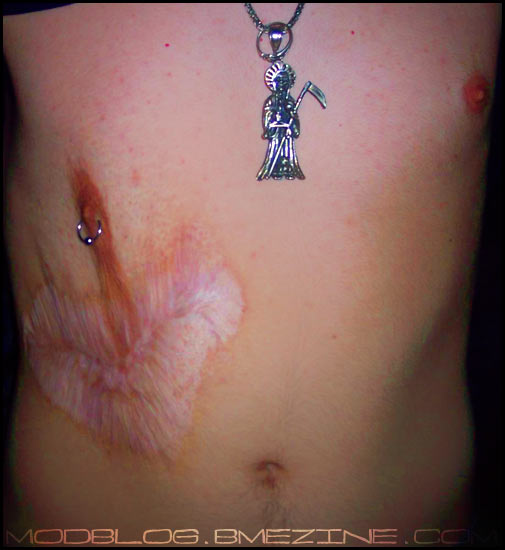|
On Pins and Needles: |
My friend “Mr. Thomas” was the artist behind the “Pins and Needles” bonus gallery in BME/HARD (members-only link) until his diabetes made him decide that it might be best to put his play piercing interests behind him — as he writes, “I guess I’ve had my fun, and now that I’m approaching middle age, it’s time to leave the fast lane, and start being more careful.” In this interview we reminisce about his experiences in over thirty years of heavy play piercing, almost all of it in secret. Because his play piercing interests developed independently and without outside influence, I think you will find it an interesting contrast to the standard play piercing that is currently popular.
* * *
|
Shannon: Tell me a little about yourself. I’m in my early forties, was born in Colorado, and moved around the country a lot as my folks were in the military. We finally settled in the deep south of Mississippi in 1981. I’m an A+ certified computer technician with an extensive background in holographic imaging for over fifteen years off and on, and I’m an amateur artist who sings classical choral music and opera. I love classical music as well as all other forms of music like new age, light rock, pop, disco, and so on. I’m heavy into science fiction as well as science fact. I’m also heavy into video games to the extent that I’m building an arcade machine for my living room. I’m considered legally blind from birth. [Editor’s note: Thomas is currently involved in a number of fascinating projects that are quite public; unfortunately they can’t be talked about here without risking revealing his identity.] Shannon: Legally blind? Legally blind means that I have some vision, but not enough to drive, fly a plane, or recognize people at a distance. I also have limited fields of view, and some blind spots. In my case, I only see bellow the horizon, and my side vision is very poor. My vision in the left eye is only finger count at four feet, and the right is only correctable to 20/100 with lenses, but still both eyes have the field of view loss, and blind spots. This condition is called bilateral coloboma. It’s a congenital birth defect that involves the lack of cells that make up the light sensitive retina in some parts of the eyes, and is often mistaken for detached retina by less experienced eye doctors. The condition also affects the shape of the iris which gives me a “U” shaped pupil. Fortunately, I have brown eyes which hides this a bit. The United States Air Force medical division even did a medical documentary on my condition using video footage of me trying to read a book demonstrating another eye problem I, and many others have called “astigmatism” or something like that in which the eyes can’t fixate on a target very well, and move around too much to be able to focus properly. I chose to make holograms because there is no focusing involved. You just bounce light off carefully placed mirrors, subject matter, and film. No camera is involved. Just a dark room. But I’ve been out of the holography business for a few years due to financial reasons. Hmmm… How about a hologram of a piercing for the cover? I only wish I were set up do industrial holography for mass production. Oh well, it was just a thought. I couldn’t do a live subject, it would have to be a small replica or something. It’s a physics thing. * * * Shannon: Tell me about your play piercing interest? I frequently enjoy sticking pins into myself as an adrenaline rush as well as the satisfaction of an idle sadistic curiosity, I suppose. It’s also a kind of “mind over matter” thing. It really gets my heart pounding when I’m piercing my breasts and or nipples. It sometimes enhances sexual stimulation. Shannon: How did you discover this interest? I got started with this sort of thing more than thirty years ago when I was a kid. It all started when I accidentally crashed my bike into one of those trees that has all those long three to four inch thorns on them. Some of them stuck me very deeply in the arms, legs, and even my chest. The strange thing was that there was almost no pain, and I noticed I had become a bit aroused by the strange sensation of a dozen or so of these thorns stuck in me. Ever since that day I found my self experimenting with just about every pin and needle I could lay my hands on, and I also got extremely fascinated by images of acupuncture being done, or injections being given. The next thing I knew, I found my self stealing my mother’s pins and needles and sticking them just under my skin in my fingers, and arms at first, and then a few months later, I started experimenting with inserting them into my breasts. The sensation of having pins stuck deeply into my breasts was awesome, and very arousing. I’m sure my mother wondered what was happening to all those pins she noticed missing from her sewing box! Shannon: What specifically do you enjoy about it? The sexual thrill, the rush, sexual, rush, and curiosity drove my obsession with needles and piercings. Shannon: Do you think being blind plays a role in it at all? There may be something to that, as tactile sensation does play an important roll in the life of someone with visual problems… Yes, it certainly played a major roll in my piercing sessions. Shannon: When you started play piercing, did anyone know what you were doing? All of this was happening while I was still in grade school, and I wasn’t even ten years old yet. I tried my first deliberate self inflicted piercing back in 1975. It was not much, just under the skin of my hand, and a friend of mine and I would freak out the girls in our class by showing them what we had mastered. Shannon: Did you continue to “share” your interest? Back in 1975, I really kept to myself, and only showed one close friend this activity. I think my mother was aware of my activity back then when she noticed a small scar on my left breast — she is a nurse, so she would know these things. My friend’s reaction was “You are weird!” But, he got over it, and I never pressed the issue with him. Even today, only about three other friends of mine know about my play piercing activity. Sometimes I’ll tell this to those I want to run off that I don’t want to be bothered by relationship-wise if they don’t get the message. It works well. Shannon: How did your play piercing interest escalate? For about twenty years or so I mainly stuck to shallow insertions just under the skin of my belly, and chest, and then gradually worked my way up to experimenting with the more dangerous straight in, and deeper piercings. I damned near punctured a lung with one of these stunts, but the sensation I felt of a needle that deep was awesome. But I came to my senses and never went quite that deep again. Shannon: When did you start doing play piercing in your nipples? It wasn’t until just a few years ago that I started exploring the intense sensation of pushing a needle deep into my nipples, and giving them a light twist. Even then, I still had not tried going through the nipple like one would for putting in jewelry. My first nipple piercing was of course straight in, and deep. This was an awesome sensation, and I did it frequently for a long time. I tried my first full breast skewering just within the last couple of years. I have slowed down my piercing activities recently as diabetes makes it take longer for the body to repair itself. But I still engage in it from time to time. A few years ago, I wanted to use very long needles for full breast skewering, and deep penetration, but could not find any anywhere, so I experimented with making my own needles from 18 to 20 gauge steel rods or wire, and a dremel with a sharpening stone on it. These actually worked better than the common straight pins I had. But I got tired of making my needles, and actually found a source for long hat pins through Manhattan Wardrobe Co in New York City, and a few other sewing supply houses that sell nice two and a half to three inch corsage pins as well. I suppose that in my time, I’ve used everything including common straight pins, safety pins, tacks, push pins, home made pins, hat pins, corsage pins, and even acupuncture needles, of which I was even able to find six inch versions although these are so flimsy you really have to work to use them. The only type of needle I have not used yet are the injection type needles. I won’t use these for several important reasons. Most importantly, they are not cheap. Second most important, they do a lot of tissue damage because they have an off axis tip which does more cutting than piercing. Third, they are hollow, which can serve as a a vector right into the body for bacteria. Also, I’ve noticed most piercings done with these needles tend to bleed. So I stick to pins and needles that do as little damage to tissue as possible. I have yet to try suspension, and probably won’t because I’m a diabetic. Diabetics have thinner skin than healthy folks, but I may at least try having the hooks put in, and do a light pull, just not a full load suspension. Who knows. Shannon: Tell me more about the deep play piercing… Very deep play piercing has its price. It’s highly risky if you don’t know your internal anatomy, and don’t pay attention to pain. I have a nice deep scar in my left breast which was caused in part by a very deep piercing which tore a muscle when I did not do the piercing right. I simply went all the way through the muscle, and well into the rib cage. That’s when I almost punctured a lung. Turns out I was very close to the heart, because I could see the needle swinging like a pendulum. It didn’t hurt and I didn’t realize how deep I had gone until I saw it beating. The docs say there is nothing they can do about it without making the scar much worse. A pissed off iguana did not help matters by making the original scar area worse by tearing a nice gash in me when I was trying to force feed it after it had gone off feed from being sick. I neglected to get the injury looked at in time, and the resulting infection left the scar you now see. A friend said to me, “Well, that’s what happens when you breast feed an iguana!” These days, I’m more careful about not going into muscle tissue now that I know more about the fact that damaged muscle fibers won’t grow back. I stick to deep penetration, but stay out of the muscles. I’ve never been asked by a doctor about the scar. I also have noticed my nipples now have permanent holes where I had been going into the same part of the nipple repeatedly. After a few months of rest, they are finally starting to close up. As for the through and through breast skewering, this was partly inspired by the Slave Misty gallery, and I wanted to just try this for myself. I have not seen or experienced any ill effects from having done this, other than one bleed out that got my attention. No muscle tissue was affected by this. It was an extremely intense experience which really did not hurt at all. I did have one nasty experience where after getting twelve five inch hat pins through one breast, and taking all those pictures, and after taking the pins out, I closed out my imaging program before saving, and had to redo the whole shoot on my other breast. That’s why in some shoots you see a needle scarred breast in the first shots. Shannon: What does the sensation feel like to you? Actually I feel no pain other than a slight pinch on entry. I learned very early that you will only feel pain if you go into a nerve packed area and ignore the burn. In case anyone is wondering, I don’t jam the needles in fast — I have found that it’s better to insert slowly. This lets me listen to my body, and if it does hurt, I can pull out, and try another site. Also, if you jab, you run the risk of breaking blood vessels, or hitting nerves, to say nothing of the risk of going through the ribs, and hitting an organ. By inserting slowly, the tip of the needle will simply glide around blood vessels, leaving them intact for the most part. Shannon: Are there ever issues with bleeding or other complications? Actually, in all the thirty years I’ve been doing this, I’ve only had about three or four bleed outs that really got my attention. Two of them can be seen in some of my later submissions which show about a dozen or so five inch hat pins inserted all the way through the breasts. Most of the times I luck out, and don’t get a single drop. Other times I might get a tiny drop of blood, what we call a micro bleed. Most often, the bleeds I do get happen between the nipple, and the arms where there are blood vessels found closer to the skin. Shannon: Let’s talk a bit about different kinds of needles — it looks like you often use simple push-pins, rather than something medical? Nothing is more frightening than to try to pull a pin out of your body only to have the head of the pin come off in your hand. This happened to me once, and I’m glad that pin had not been inserted all the way to the head of the pin like I used to do. If it had, I could very well have been off to the hospital to have it removed. The pin was in my nipple, but knowing how hard it is to pull a pin from a nipple, I made sure to leave a little pin hanging out so I could grasp it easily. As it turns out, that was a good thing, because the head did come off the pin, and I had to use a vice grip to pull the needle out the rest of the way. So, when using pins with plastic, or other heads, don’t insert these all the way in, and avoid pushing them in so deep that if the head does come off, your flesh will envelop the needle. Leave enough needle hanging out that you can easily get at it if you have a problem.
Shannon: But you still prefer those needles over injection-style hypodermic type needles that seem more popular these days for play piercing? I prefer to use pins over injection needles, because the tip of a pin is perfectly centered, and does not have the cutting edges found on injection needles. That’s why injection needles go in so easily compared with pins, but it’s why you tend to bleed more with injection needles. I find I have far fewer bleeds with pins, than with injection needles. The other thing I don’t like about injection needles is the fact that they are hollow. This presents three problems. First, the hollow tube can act as a vector for pathogens to be transported right into your body. It’s harder for this to happen with pins, though not impossible. Second, the hollow tube can contribute to a frightful bleed out, if you don’t pull the needle out of whatever blood vessel the tip has intercepted. Finally, a hollow needle is more prone to bending or possibly even breaking than pins of the same gauge. |
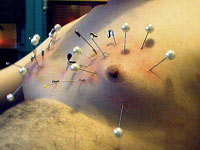 |
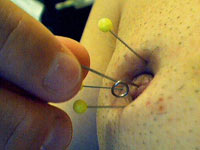 |
|
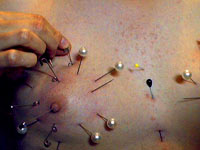 |
|
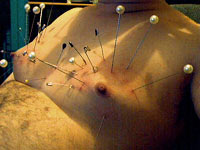 |
|
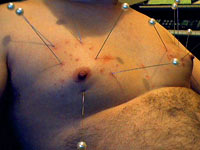 |
|
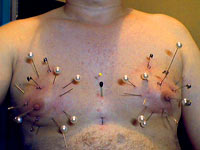 |
|
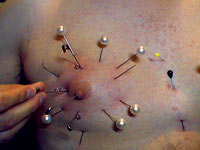 |
|
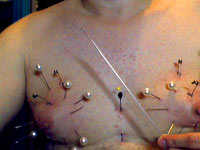 |
|
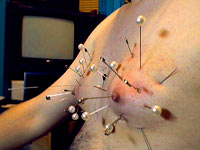 |
|
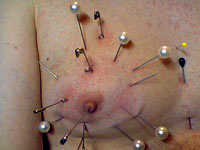 |
|
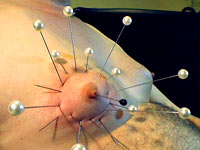 |
|
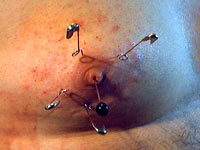 |
|
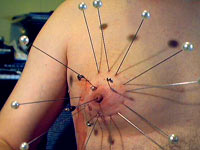 |
|
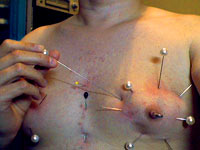 |
|
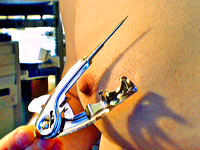 |
|
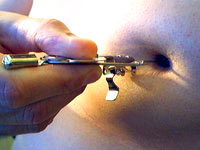 |
|
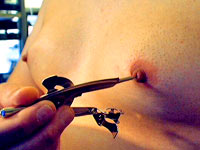 |
|
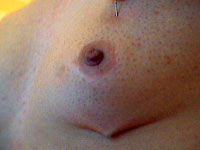 |
|
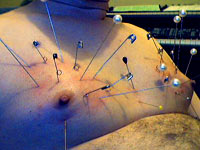 |
|
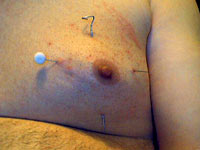 |
|
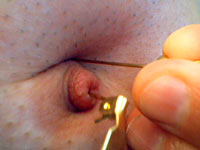 |
|
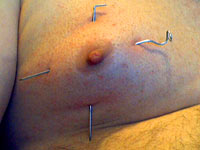 |
|
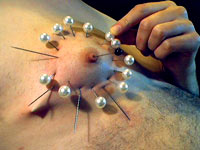 |
|
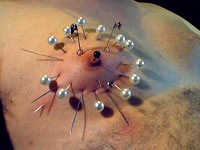 |
|
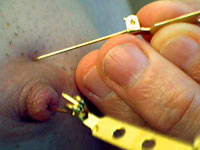 |
|
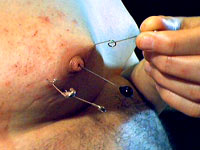 |
|
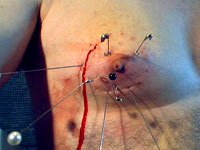 |
Shannon: What gauge and size of needles do you use?
I prefer to use needles of about 20 to 30 gage in size, because they do the least amount of damage to tissues. Acupuncture needles, are fine, if you use lengths under three inches. I have six inch acupuncture needles, but the gage is 28 which is just too flimsy to easily insert the needle all the way through my breasts. For this type of activity, I suggest a bit thicker needle that’s not too flimsy, but not so wide that it causes scars. I usually use six inch hat pins for going through my breasts, but never stick these into your rib cage, or insert in any direction that puts internal organs at risk. Just “stick” to surface to surface piercings, or deep piercings that don’t put you at risk.
Most acupuncture needles come with a tube. This tube is not for shipping purposes. It is used to start the insertion of the needle, and aids in easy insertion. You use it by placing the tube firmly against the skin, and then inserting the needle through the tube with a gentle tap. You will find the needle goes in much easier with the tube, because the tube stretches the skin, and keeps the skin from gripping the needle. It also provides rigidity to the needle while inserting. In some cases I’ve found it easier to shorten the tube by about no more than half an inch for the six inch acupuncture needles. This lets you get the needle in deep enough so that when you take away the tube the needle is less likely to flop around.
The larger the needle diameter (lower gauge), the greater that risk of infection as the hole the larger needle makes will also be larger. There is also greater risk of long term damage to tissues, blood vessels, and nerves.
For deep straight-in piercings, I prefer to straighten out a safety pin, or even make my own needles from 20 to 30 gage wire with a coiled, or bent head that I know won’t come off. You can go as deep as you like without worrying about plastic pin heads coming off, and leaving a pin buried in you.
* * *
Shannon: I saw there were some photos where you were breast pumping… What was your motivation in trying that?
The breast pumping was originally intended for enlargement purposes, but as I discovered it was not really working, it later just became little more than a kinky toy thing. I have discovered the danger of over pumping when I noticed one of my nipples bleeding. I also got tired of the “ring around the boob” effect of prolonged pumping. These happen when done for more than twenty minutes at a time, and when over pumped. I no longer engage in pumping other than as a funny looking kinky toy for entertainment purposes these days.
Shannon: You mentioned you sometimes do genital play piercing as well?
I generally stay away from the genitalia when it comes to piercings because that’s a high bacteria risk area, and especially for a diabetic — this is a no-go zone for me. Even healthy folks need to be especially careful with genital piercing, either play, or permanent [Editor’s note: I disagree with this assessment personally, as well as a few of the others]. This is also a high bleed out risk area for anyone. If done carefully, and if one takes the time to study internal anatomy, and learn where arteries, and nerves are, and exercises cleanliness, and sterile protocols, one can have a great experience with genital play, and permanent piercings.
Shannon: Since you occasionally cross-dress, do you mind telling me how you’d characterize your sexual orientation?
I actually consider myself multi-sexual in that I could easily go either way, and even though I have no desire to have a sex change, I also don’t have a problem with my large breasts, although I lately find myself gravitating more towards heterosexuality. A close friend dared me to try a bit of cross dressing, although that’s not my thing. It was an interesting twist just to see what a fat guy with a mustache would look like in a hot red boob out. It’s not the sort of thing I engage in on a regular basis. It was also done because I do have “A-cup” breasts. It was fun, but it’s behind me now, as they say. Who knows, I might try it again some day. I don’t mind talking about this to my close friends, or even with you for this, but it’s not something I’d rant about at the office.
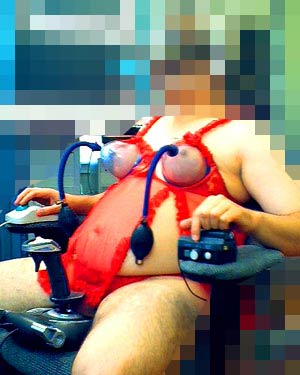
Shannon: I have to ask you about your dress-up and computer gear in this hilarious photo — was that just a joke photo?
The computer gear is real, and in use, and you’re right, it was a hoot!
Shannon: Ever think about getting permanent piercings?
I have considered permanent piercings, but never had it done for financial reasons, and because of horror stories about angry lovers ripping them out on people. I’m also concerned about the long term affects of metal or plastic in one’s body, and am looking into any research that may be ongoing in this area. I have heard of some kinds of metal causing permanent tissue damage from metallic poisoning, but it’s pretty rare, and usually involves inferior quality jewelry, so I’m still looking into reliable sources for jewelry. I don’t think having permanent piercings would defeat the purpose of play piercing, but they might have some impact on how I went about the practice. That’s something I may have to explore someday.
* * *
Shannon: Any advice to people who want to try this sort of thing?
Make sure you are mentally ready for this activity. You don’t want to engage in this activity if you have thoughts of suicide, or of bringing harm to yourself, or others. Never do piercings if you are in a bad mood. And never do it in a thunderstorm when you might jump when a clap of thunder hits. This could be bad.
Shannon: Let no one say you don’t have

